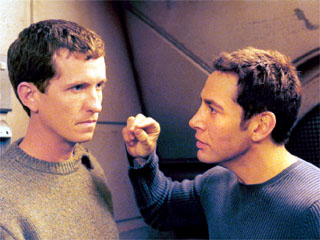Into Their World *This is "Part 2" of my effort to take you on a hunt for whitetail deer. "Part 1" can be found here...
*This is "Part 2" of my effort to take you on a hunt for whitetail deer. "Part 1" can be found here...As the door closes with a swoosh and a click, the air has grown routinely colder than that first morning of archery season, now almost six weeks earlier. Rifle season is almost two weeks old and it gives me the "reach" I might need if I get so lucky as to see again the deer I have since nicknamed "Buckzilla".
When I saw him on October 14th at 5:46 PM, the light was perfect, his stride could be followed and it was laced with convenient pauses as he "rubbed" his horns on the occasional hardwood tree. His neck was swelled up with the lust that fills him earlier than when the female "doe" will come into estrus and only then allow him to mate. He was alone, brassy and yet moved with a perceptive, acute radar of what might be near him. He was so old he was greyish brown...and broad across as a steer.
He would eat like the toughest shoe leather (and I am not one to normally hunt for 'trophies'), but he was such a magnificent beast that no one with the opportunity would pass on him just for fear of having to reach for the meat tenderizer. It was a jaw dropping sight after a quiet afternoon of sitting motionless and viewing the same woods in every detail for so long that you are almost convinced that no animals really live here anymore.
Just... *poof* ...he is there! So sudden and seemingly miraculous, yet at the same time he really does look perfectly fitting to his surroundings.
But he was too far away to reach with an arrow. All I could do was watch as he disappeared. With the rifle in my hands and a season to allow it, he would have gone home with me that evening. But it was not to be. These difficulties build character, I pray. That kind of anguish simply must have some God sent positive. Wow! Let the obsession begin!
The thing is, mature male deer, "bucks", are creatures of meticulous habit. And my treestand is now proven to be on his "route". So my duty becomes to sit on that route as often and as long as possible until he comes through, maybe, just maybe, again. When he goes into "rut" and begins mating, he could be anywhere at anytime and it is the only time he will abandon his ultra-conservative protection tendencies. But for now, and until then, I need to be in that stand, especially in the first hours of morning and the last hours of the afternoon. No rules for him to follow, either, yet there are plenty for me to adhere to... and
strictly. No guarantees or promises of any kind ...that's one of the challenging parts of the pursuit. And there are many other things for me to potentially screw up. But first,
I have to be there when he comes through or
I get no chance at all.
Now I carry my rifle rather than the bow and I can shoot anywhere I can see. With the bow, I draw the line at 25 to perhaps 30 yards. That means that you are only immediately responsible to see deer that are that close to you for them to be in 'the range' ...anything sighted further away is simply a complimentary early warning ...and may not come into your zone at all anyway. But with the additional range of the firearm, you are also instantly responsible for all the little nooks and crannies and patches of openings within your 360° field of view where a deer might walk through momentarily. In that stand location, I can see (not necessarily shoot, due to branches and obstructions) as far as 135 yards in a couple of spots. This is not Kansas! That's a long way in tight woods. So with capability comes more nerve racking territory to try to watch simultaneously, or perhaps...
miss your chance.

When I began back in archery season, I was using two "climbing tree stands" placed in different locations. Their typical operating height is 15' to as much as 30' or a bit more on the right tree. They are cramped, but well suited to bow hunting and they allow me to easily move the stand to a new tree location if I choose. Since you have to be so close when archery hunting, you have to go where deer are frequenting most. This sometimes requires new choices as conditions and deer movement change.
That Saturday evening that I saw old 'BZ', I had recently instead relocated myself to a twelve year old, permanent stand I built in a double oak tree quite a distance from where I was formerly using the climbers. It sits on a knoll, well within the forest, covered with a grove of oak trees and also peppered about with miscellaneous 4 to 12 foot White Pines (acorns for food and the pines give seclusion). It is 34' at its' deck, fully enclosed with three foot high walls, a trapdoor in its' floor with a custom, steel re-bar hanging ladder in place to gain entry. It is camoflauged and well hidden. It is also very comfortable and quiet, with a stool (internally heated by candle when really cold) and decent wind protection. The view from the "theatre" is what I liken to looking down into a dollhouse with the roof removed. On the ground, your line of sight rarely exceeds ten yards and is usually five or less. From my perch, I can see at least fifty yards in most directions (with a few nearly one hundred yard shooting "holes") into that same dense growth. But first you have to get there...
I do use my Mini-Mag flashlight to get across my yard on the way into the woods. One of the girls is still a puppy and, although she easily was trained to do 'business' outside, we haven't yet made the connection that "outside" begins
at the woods edge and beyond! There is nothing pleasant about being late to get into your stand because you have to wash dog doo out of the intricate treads of your once-but-no-longer de-scented hunting boots! Hopping around on a one sock foot, trying to wash, not touch, not splash, not stand in
&^%* again, in the dark, with ice cold hose water... I challenge you to do this and not say bad words at volume levels that you then silently hate yourself for using. One mistake reminds for the duration of the season... or, a little dab will doo ya'!
If there simply is no moonlight to allow you to walk in, then you have no choice but to use the flashlight. I turn it on facing my stomach and rotate the lens the required amount to give a narrow, focused beam. I then use it only pointed directly down at the ground, immediately in front of my next steps, and follow my trail in to the base of the target tree. The closer the flashlight is to the ground while not pointing it "out" but only "down", the less viewable it is from points nearby. I know where the trail goes so there is no need to light what I am approaching up ahead, only that which is immediately in front of me.
My trails to my stand locations are trimmed just wide enough to slip through without hitting branches with body or gun. The paths are left natural, but also trimmed and picked clean of branch pieces and debris that would make excess noise underfoot. Keeping them picked clean becomes part of the routine of using them in times of light... exiting after a morning hunt or entering before an afternoon hunt. I prefer to go into my morning stands in the dark whenever there is enough moonlight and/or starlight to allow this. I line the sides of my trails with pieces of dead and fallen white birch to give reflective contrast with even the smallest amounts of existing light. I also wear my hat brim low over my eyes and don't look up at the moon or stars... that makes your pupils smaller and undoes the good night vision you had going to that point. I typically spend 20 to 25 minutes getting to my tree.

Everyone has their own opinion it seems about when to go in to your morning stand. Many maintain that you should go in only after first legal shooting time. This way, if you "jump" a deer that was on or near your path, you may have the opportunity to get a decent shot. I find that, in practice, that is rare, especially in the heavy cover around my entry route and near my stand. When disturbed, deer move very, very quickly and it is really tough to get any opening in dense woods. In good conditions, I can hit a running deer, but I don't take poor shots. If you were walking down the edge of an open field, I would go in after it was legal light. But in the deep wooded cover I like to hunt, I want to be in my stand all settled and silent early... I like to be an hour early, sometimes a bit more. It gives the woods plenty of time to 'normalize' and settle down.
Going in early in the dark, there is still a very real chance you may jump deer. They usually feed and move at night. With dry, crackly leaves, I take three or four gentle steps at a time and stop. (If the leaves are wet at all, then they are quiet, too, and I can just carefully walk in.) A ten to fifteen second stop time between step sequences makes you sound more like another deer in the woods. If you don't stink and are otherwise quiet, nearby deer can't necessarily tell you are a person. If deer are near your walk to your stand, they are going to hear you... better they wonder what you are than know immediately. If you don't really scare them, much better chance you will see them in the area again later, after you are situated and have light.
I touch down the advancing foot on toe tips and smoothly roll contact back onto the heel. If I step on something really noisy, I dramatically slow the roll to the heel and it will lessen the noise. It's like the difference between separating velcro fast or very slowly. The resulting noise volume is way reduced. Discipline, discipline, planning ahead and more discipline.
If I "bump" deer on the way to the stand, I freeze up and mute my flashlight's beam immediately. They will often "blow" if they detect another 'something' nearby to them. They blow their entire lung capacity out through their nostrils in a sort of exhaling snort, which indicates to the other deer they might be with that they are alarming over some possible danger. It is a very dramatic, noisy and intriguing response! To continue my own deer emulation, I will usually "blow" right back at them, and then remain rigid and still! This many times amazingly will bring about more curiousity than fear from the deer. Frequently, they also will stomp one front hoof repeatedly into the ground every eight or ten seconds, another danger warning and meant to be a bit confrontational, especially if they perceive me to perhaps be another deer. It is a generally good sign they are at least unsure. Multiple blows are also a common response.
Many times, a situation like this will dissipate, often without them running away scared. They will just snort and blow and be generally 'pissy' and slowly work away from me. One time, the snorting and stomping lasted for almost
50 minutes in a pitch black night! There were four deer on three sides of me, anywhere from roughly eight to maybe fifteen yards away. I was bow hunting that time and just praying for it to last long enough to have light and perhaps get a sight pin on one... it is quite a challenge to take a deer from the ground while walking with a bow! But, as it turned out, they departed (again slowly and without any real alarm) about ten minutes before there was any kind of useable light. Oh, well. It was still a
really cool, exciting experience and a fine example of great things you may encounter while hunting!

To get comfortable with doing all the entry steps in the dark, everything is practiced before the season in the daylight. Which foot goes up on the ladder first, which rungs favor weight to one side or the other to avoid a characteristic creak, a seamless entry into the platform without dragging clothing across anything noisy, closing the trapdoor just right to avoid any sound, etc.. It soon becomes quite interesting just how well you know all the intricacies through rote, and how good you can become at getting all the necessities done while being just about silent. Eventually, the whole sequence of moves takes just about the exact same amount of time, right down to the minute. There is a confidence and satisfaction that comes with these little things. Above all else, your awareness of what is out of the ordinary becomes amazingly keen.
Once you get above about 30', it is rare that deer will smell your scent or see your careful movement (in my experience, at least). So for me,
real treestand life begins there and above. But falling from that height or more is almost certain death or major injury (probably followed by more slow, painful death!). Most falls occur when the hunter is getting into or getting out of his stand. It is rare that someone falls out once in place. I climb into the stand in the darkness with no light burning to further disturb the woods. You really don't need it. Everything can be done reliably by feel and existing light only once you start up your ladder and know the drill.

I have this year added a catch-fall line which runs parallel and adjacent to my ladder. It attaches, via a short lanyard, to my catch-fall harness on my back and shoulders. The lanyard is attached to the vertical catch-fall line with a sliding knot called a
Klemheist. If the lanyard is alone pulled in the down direction (you're falling now), the knot instantly grabs the vertical line and your fall is stopped. Otherwise, the knot can be easily, quietly slid up the vertical line as you ascend keeping your maximum fall distance to the length of the lanyard only. It can also be slid down the catch-fall line when descending, affording you the same fall prevention. It is an ingenious, simple device and I LOVE it! After eleven years in that stand, I will never risk falling again when it is so easily avoided.

Once in the stand, the trapdoor is closed and the rifle is hauled up on its' own dedicated rope hanging opposite the ladder side. The rifle gets positioned across the rails at the south end of my little 4' X 3' rectangle. My stool is righted, positioned gently and I can sit down.
One of my favorite parts comes right now. It is time to drink in big puffs of crisp, cold air and stare up at the stars. Meteors streak across the silent black sky. The satellites drift over, catching and reflecting the still unseen rising sun, along with the occasional high elevation Trans-Atlantic flights headed south to one of the big cities. Many mornings I see the International Space Station drift noiselessly by at over 17,000 mph. The old oak's gnarly arms silouhette themselves against a blue black background, hardly any paper bag leaves remaining.

Now I can play a mind movie of memories and solve all the World's problems as I wait for the first grey light.

 to be continued...
to be continued...
























 But either way, that is the course they are now on. Regretfully, the day will soon dawn in Lebanon with a President Hassan Nasrallah in place, giving control of a former democratic nation to a seething, unmerciful group of murderous terrorists.
But either way, that is the course they are now on. Regretfully, the day will soon dawn in Lebanon with a President Hassan Nasrallah in place, giving control of a former democratic nation to a seething, unmerciful group of murderous terrorists.























